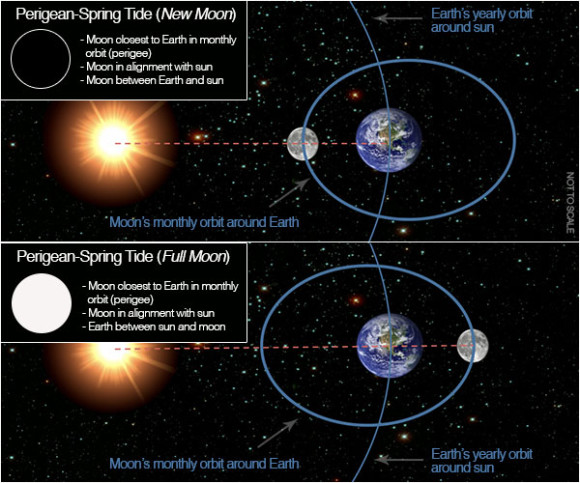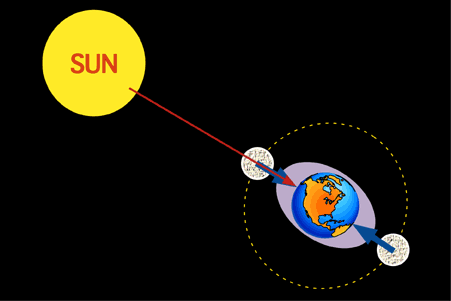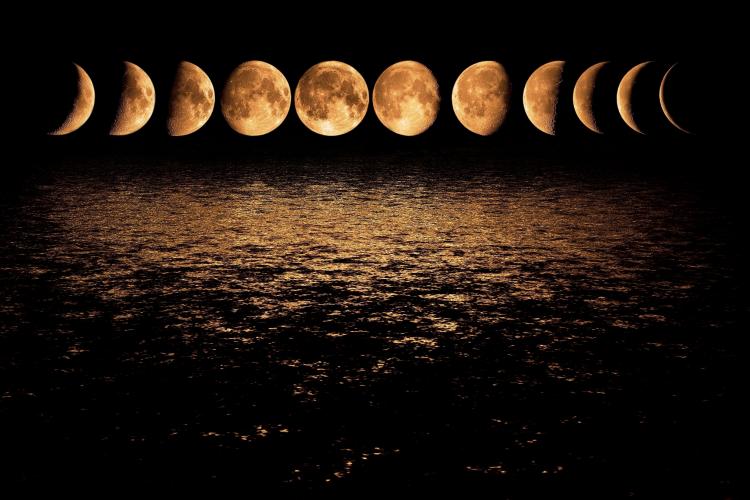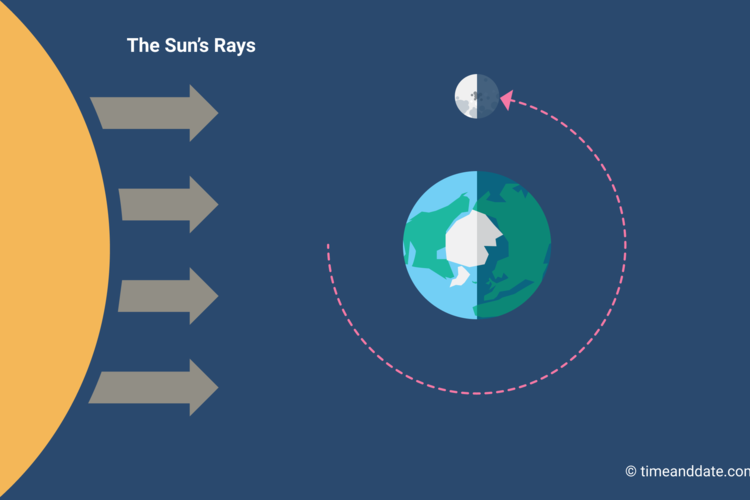











Photography and the moon, this is an interesting subject to photograph, but just how many moons are there. Lets find out.
What is a supermoon? Astrologer Richard Nolle coined the term supermoon over 30 years ago. The term has only recently come into popular usage. Nolle has defined a supermoon as:
… a new or full moon which occurs with the moon at or near (within 90% of) its closest approach to Earth in a given orbit.
That’s a pretty generous definition, which is why there are so many supermoons. By this definition, according to Nolle: There are 4-6 supermoons a year on average. Another astronomical term for a supermoon is a perigee full moon, or a perigee new moon. Perigee just means “near Earth.”
The moon is full, or opposite Earth from the sun, once each month. It’s new, or more or less between the Earth and sun, once each month. And, every month, as the moon orbits Earth, it comes closest to Earth. That point is called perigee. The moon always swings farthest away once each month; that point is called apogee. Supermoon is a catchier term than perigee new moon or perigee full moon.
We first became familiar with the supermoon label in the year 2011 when the media used it to describe the full moon of March 19, 2011. On that date, the full moon aligned with proxigee – the closest perigee of the year – to stage the closest, largest full moon of 2011.

When are the supermoons of 2015? By Nolle’s definition, the new moon or full moon has to come within 361,836 kilometers (224,834 miles) of our planet, as measured from the centers of the moon and Earth, in order to be considered a supermoon.
By that definition, the year 2015 has a total of six supermoons. The first supermoon, for 2015, came with the January 20 new moon. The new moons on February 18 and March 20 were also considered supermoons, according to Nolle’s definition, and that same definition dictates that the full moons of August, September and October will be supermoons, too.
The full moon supermoons or near-perigee full moons for 2015:
Full moon of August 29 at 18:35 UTC
Full moon of September 28 at 2:50 UTC
Full moon of October 27 at 12:05 UTC
The full moon on September 28, 2015, will present the closest supermoon of the year (356,896 kilometers or 221,754 miles). What’s more, this September 28, 2015 full moon will stage a total lunar eclipse, concluding a series of Blood Moon eclipses that started with the total lunar eclipse of April 15, 2014.
In 2015, the moon comes closest to Earth on September 28 (356,877 kilometers), and swings furthest away some two weeks before, on September 14 (406,464 kilometers). That’s a difference of 49,587 kilometers (406,464 – 356,877 = 49,587). Ninety percent of this 49,587-figure equals 44,628.3 kilometers (0.9 x 49,587 = 44,628.3). Presumably, any new or full moon coming closer than 361,863.1 kilometers (406,464 – 44,628.3 = 361,835.7) would be “at or near (within 90% of) its closest approach to Earth.”

Spring tides will accompany the supermoons, the tides be larger than usual at the January, February and March 2015 new moons and the August, September and October 2015 full moons. This is because all full moons (and new moons) combine with the sun to create larger-than-usual tides, but closer-than-average full moons (or closer-than-average new moons) elevate the tides even more. We witnessed this in Zanzibar this year August.
Each month, on the day of the new moon, the Earth, moon and sun are aligned, with the moon in between. This line-up creates wide-ranging tides, known as spring tides. High spring tides climb up especially high, and on the same day low tides plunge especially low.
The closest new moon of the year on February 18 and the year’s closest full moon on September 28 are bound to accentuate the spring tide all the more, giving rise to what’s called a perigean spring tide. If you live along an ocean coastline, watch for high tides caused by the September 27-28 perigean full moon.
Will these high tides cause flooding? Probably not, unless a strong weather system accompanies the perigean spring tide. Still, keep an eye on the weather, because storms do have a large potential to accentuate perigean spring tides.
Dates of closest full supermoons in past and future years. More often than not, the one day of the year that the full moon and perigee align also brings about the year’s closest perigee (also called proxigee). Because the moon has recurring cycles, we can count on the full moon and perigee to come in concert in periods of about one year, one month and 18 days.
Therefore, the full moon and perigee realign in periods of about one year and 48 days. So we can calculate the dates of the closest full moons in recent and future years as:
March 19, 2011
May 6, 2012
June 23, 2013
August 10, 2014
September 28, 2015
November 14, 2016
January 2, 2018.
There won’t be a perigee full moon in 2017 because the full moon and perigee won’t realign again (after November 14, 2016) until January 2, 2018.
Looking further into the future, the perigee full moon will come closer than 356,500 kilometers for the first time in the 21st century (2001-2100) on November 25, 2034 (356,446 km). The closest full moon of the 21st century will fall on December 6, 2052 (356,425 km).
By the way, some astronomers will call all the full moons listed above proxigee full moons.
Click here to see how the Supermoon Blood Moon played out in the Cape Town area in 2015
“Once in a Blue Moon” is a common way of saying not very often, but what exactly is a Blue Moon?
According to the popular definition, it is the second Full Moon to occur in a single calendar month.
The average interval between Full Moons is about 29.5 days, whilst the length of an average month is roughly 30.5 days. This makes it very unlikely that any given month will contain two Full Moons, though it does sometimes happen.
On average, there will be 41 months that have two Full Moons in every century, so you could say that once in a Blue Moon actually means once every two-and-a-half years.
Defining the Original Blue Moon
The correct, original definition is that a Blue Moon is the third full Moon in an astronomical season with four full Moons. A normal year has four astronomical seasons – spring, summer, fall (autumn), and winter – with three months and normally three full Moons each.
When one of the astronomical seasons has four full Moons, instead of the normal three, the third full Moon is called a Blue Moon.
Next Blue Moon
(Second full Moon in a month)
31 January, 2018
31 March, 2018
31 October, 2020
Blue Coloured Moon
Astronomical Blue Moons happen either once every two to three years or so, depending on which of the two definitions you apply.
A Moon that actually looks blue, however, is a very rare sight. The Moon, full or any other phase, can appear blue when the atmosphere is filled with dust or smoke particles of a certain size; slightly wider than 0.7 micron. The particles scatter the red light making the Moon appear blue in color, this can happen for instance after a dust storm, forest fire or a volcanic eruption.
Eruptions like on Mt. Krakatoa, Indonesia (1883), El Chichon, Mexico (1983), Mt. St. Helens (1980) and Mount Pinatubo (1991) are all known to have caused blue moons.
The Science Behind Blue Moons
There are two astronomical definitions of a Blue Moon; both are a type of Full Moon. When the Moon very rarely actually looks blue, it’s because of a certain size dust particles in the atmosphere.
The Next Blue Moons
The phrase, once in a Blue Moon, is colloquially used to suggest that something is very rare. But just how rare, depends on your definition.
In astronomy, Blue Moon is defined as either the third full Moon of an astronomical season with four full Moon or the second full Moon in a calendar month.
Such a blue Moon (second full Moon in single calendar month) occurred on Friday, July 31, 2015 at 10:43 am UTC.
What is a Blue Moon?
Contrary to popular belief, a Blue Moon is not actually blue in color. Blue Moon is a term that is used to describe the third full Moon of an astronomical season that has four full Moons.
There are 4 astronomical seasons in a year:
Spring – March Equinox to June Solstice
Summer – June Solstice to September Equinox
Autumn – September Equinox to December Solstice
Winter – December Solstice to March Equinox
When one of the seasons in a year has four full Moons, instead of the usual three, the third full Moon is called a Blue Moon.
How Rare Are Blue Moons?
These days, the second full Moon in a calendar month is also often referred to as a Blue Moon. This particular use was popularized due to a miscalculation published in a 1946 article in Sky and Telescope magazine. Such Blue Moons occur rather frequently – at least once every two or three years. The next such blue Moon occurred on July 31, 2015.
A Rare Exception
Blue colored Moons do rarely occur when dust or smoke particles in the air are of a specific size. Such particles help create a blue colored Moon by scattering blue light.
Red Moon, which can be caused by other sizes of dust particles or lunar eclipses, are much more common than Blue Moons.
Why the Third Moon?
There are different accounts of why the third full moon of a season of four full Moons is called a Blue Moon.
For instance, the Ecclestical calendar, which indicates the dates of the Christian fasts and festivals, uses the phases of the Moon to determine the exact dates for holidays like Lent and Easter. The month of Lent contains the Lenten Moon. The first full Moon of Spring – also known as Easter Moon or Paschal Moon – falls a week before Easter. In order to ensure that Lent and Easter coincides with the phases of the Moon, the calendar has termed the third Moon of the season as the Blue Moon.
Another version of this is that since each full Moon of a normal year already has a given name, for instance Harvest Moon, the 13th nameless full Moon in a year was named a Blue Moon. This way the lunations and calendars were aligned to make sure celebrations and customs would still fall during their “proper” times.
About once every 19 years, the month of February does not have a full Moon. The years when this happens, also have two full Moons in two different months. This phenomenon will occur next in 2018.
If the second Full Moon in one month has a special name, what about the second New Moon?
Most people don’t notice New Moons. It’s easy to see the Moon when it’s full, but the only way to tell when a New Moon is happening is during an eclipse, or by referring to an almanac or using a Moon Phase calculator.
To Wiccans, the second New Moon is called the Black Moon, and any magic worked during that period is deemed to be especially powerful.
Of course, the chances of two New Moons falling within one calendar month are just the same as two Full Moons, but because New Moons are generally invisible, most people tend not to notice the occasions when a month has two of them.
That’s not to say that New Moons aren’t important to non-astronomers. To the world’s Muslims, the date of New Moon is of great interest, since the Islamic calendar is governed by the phases of the Moon: the start of each month is marked by the first sighting of the new crescent Moon.
Another definition – four New Moons in a season
According to an article in the May 1999 issue of Sky and Telescope, the traditional definition of a Blue Moon is the third Full Moon in a season which has four Full Moons. Compilers of almanacs such as the Maine Farmer’s Almanac would use a coloured symbol to denote this third Full Moon, hence the name.
Similarly, a Black Moon can be the third New Moon in a season which has four New Moons.
The next Black Moon: Dates and times are given in Greenwich Mean Time.
September 20, 2017 0530 GMT
September 17, 2020 1100 GMT
The term Black Moon doesn’t come from astronomy, or skylore, however from Wiccan culture. It’s the name for the second of two new moons in one calendar month. January 2014, for example, had two new moon supermoons, the second of which was not only a supermoon, but a Black Moon. Does a Black Moon have to be a supermoon in order to be called Black, no not at all.
The next Black moon by the above definition will occur on October 30, 2016. Other names for the second new moon in a month: Spinner Moon, Finder’s Moon, Secret Moon.
Another definition for Black Moon: the third of four new moons in one season. This last happened with the new moon supermoon of February 18, 2015, because this particular new moon was the third of four new moons to take place between the December 2014 solstice and the March 2015 equinox. The next Black Moon by this definition will occur on August 21, 2017, to feature a Black Moon total solar eclipse in the United States.
Bottom line: The term supermoon doesn’t come from astronomy. It comes from astrology, and the definition is pretty generous so that there are 4 to 6 supermoons each year. This post explains what a supermoon is, how many will occur in 2015, which moon is the most “super” of all the 2015 supermoons, and gives a list of upcoming full supermoons for the years ahead.
he “Harvest moon” and “Hunter’s moon” are traditional terms for the full moons occurring during late summer and in the autumn, in the northern hemisphere usually in August, September and October respectively. The “Harvest Moon” is the full moon closest to the autumnal equinox (22 or 23 September), and the “Hunter’s Moon” is the one following it. The names are recorded from the early 18th century. The names became traditional in American folklore, where they are now often popularly attributed to the Native Americans. The Feast of the Hunters’ Moon is a yearly festival in Lafayette, Indiana, held in late September or early October each year since 1968. In 2010, the Harvest moon occurred on the night of equinox itself (some 51⁄2 hours after the point of equinox) for the first time since 1991.
All full moons rise around the time of sunset. Because the moon moves eastward among the stars faster than the sun its meridian passage is delayed, causing it to rise later each day – on average by about 50.47 minutes. The harvest moon and hunter’s moon are unique because the time difference between moonrises on successive evenings is much shorter than average. The moon rises approximately 30 minutes later from one night to the next, as seen from about 40 degrees N or S latitude. Thus, there is no long period of darkness between sunset and moonrise for several days following the actual date of the full moon
Several cultures around the world have used the Moon as the basis for their calendars, to determine the seasons, and to set the dates of harvest and holidays at some point in their history.
Here are some commonly used full Moon names in North American culture:
January – Wolf Moon
Also known as the Moon after Yule, Old Moon or Snow Moon, the full moon in January was named after howling wolves.
February – Snow Moon
February’s full moon was dedicated to the snowy conditions that marked the month. It was also sometimes called the full hunger moon by North American tribes who would find their food sources depleted due to the winter.
March – Worm Moon
The last full moon of the winter season in March, is also known as the Lenten Moon, the Crow Moon to signify the crows that appear at the end of winter, and Sap Moon to mark the time for harvesting maple syrup from maple tree saps. It is also known as the Worm Moon because of the earthworms that come out at the end of winter and herald the coming of spring.
April – Pink Moon
The first full moon in April is sometimes called the Paschal Moon in the ecclesiastical calendar because it is used to determine the date for Easter – the first Sunday after the Paschal Moon is Easter. The name Pink Moon comes from the pink flowers – phlox – that grow in many places at the beginning of spring. Other names for this full moon include Sprouting Grass Moon, Egg Moon and Fish Moon.
May – Flower Moon
The May full moon is known as Flower Moon to signify the flowers that bloom during this month. Other names for the full moon are Milk Moon and Corn Planting Moon.
June – Strawberry Moon
June’s full moon is named after strawberries that become plentiful during this month.
July – Buck Moon
The full moon for the month of July is called Buck Moon to signify the new antlers that emerge from Buck Deers’ foreheads around this time if the year. This full Moon is also known as Thunder Moon or Hay Moon.
August – Sturgeon Moon
The full moon for August is called Sturgeon Moon because of the large number of fish that can be easily found in the lakes in North America. Other names for this full moon include Green Corn Moon or Grain Moon.
September – Harvest Moon
September’s full Moon is called Harvest Moon because farmers tend to harvest their crops around the full Moon.
October – Hunter’s Moon or Blood Moon
Traditionally, tribes spent the month of October preparing for the coming winter. This included hunting, slaughtering and preserving meats for use as food. This led to October’s full Moon being called the Hunter’s Moon and sometimes Blood Moon or Sanguine Moon. However, this should not be confused with a Total Lunar Eclipse – Blood Moon
November – Beaver Moon
According to folklore, the full moon for November is named after Beavers who become active while preparing for the winter.
December – Cold Moon
December is the month when winter begins for most of the Northern Hemisphere, hence, its full moon is called the Cold Moon.
Moon phases depend on the position of both the Sun and Moon with respect to the Earth. The 4 primary phases of the Moon are: new, first quarter, full and third quarter.

The intermediate phases between the primary phases are, waxing crescent, waxing gibbous, waning gibbous, and waning crescent.
A new moon is the moment when the Sun and Moon are in conjunction, meaning that the Sun and Earth are on the opposite sides of the Moon.
A New Moon cannot normally be seen from the Earth since only the dark side of the Moon faces the Earth at New Moon. Sometimes, if the New Moon is close to the Lunar nodes of its path, it causes a Solar Eclipse.

A few days after the new moon phase, the Moon will be visible again in a phase that lasts until the first quarter, called waxing crescent moon. The initial period, just after the Moon becomes visible, is sometimes called new moon, although it has another definition. Although only a small part of the Moon may be illuminated by the Sun, the rest of the Moon may also be faintly visible, due to a reflection from the Earth to the Moon, called earthshine. The waxing crescent moon is most visible after sunset. The first visual sight of the waxing crescent moon determines the beginnings of months in the Muslim calendar.

During the first quarter, half of the Moon is illuminated, as seen from the Earth. The Moon rises near the middle of the day and sets near the middle of the night. In northern regions of the world, the right part will be visible, while the left part will be visible in the southern regions. Near the equator, the upper part is bright after moonrise, and the lower part is bright before moonset (the bright part appears and disappears first).
The waxing gibbous moon occurs between the first quarter and the full moon. The sun illuminates more than half of the Moon’s surface during this period.

Each Full Moon has a name
…unless it’s a Blue Moon
Full moon appears when the Sun and the Moon are on opposite sides of the Earth. As seen from Earth, all of the Moon’s surface will be visible.
The full moon is visible approximately from sunset to sunrise. When observed from Earth, the Moon can appear to be full for a couple of days, since more than 98 percent of the Moon’s disc is illuminated a day before or after the full moon. During full moon, the Moon may pass through Earth’s shadow causing a lunar eclipse. If the whole moon is in the Earth’s shadow, or umbra, a total lunar eclipse occurs. If only a part of the Moon enters the umbra, we see a partial lunar eclipse.
The period between full moon and third quarter is called waning gibbous moon. The portion of the visible half of the Moon illuminated goes down from 100 percent to 50 percent during this period.

The third quarter moon occurs when the other half of the Moon is illuminated compared to the first quarter. On the day of third quarter, the Moon rises approximately in the middle of the night and sets in the middle of the day.
The waning crescent moon is the period between the third quarter moon and the next new moon. It is most visible before sunrise. The Sun illuminates less than half the Moon during this period. When only a small part of the Moon is visible, it may be possible to see earthshine on the dark side of the Moon.
A lunation is a cycle of the Moon. It starts at new moon and lasts until the next new moon. On average, it takes the Moon 29 days 12 hours 44 minutes to go from one new Moon to the next. This time frame is called a synodic month. The duration of a synodic month varies from one lunation to another, most importantly because the orbit of the Earth and Moon are ellipses rather than circles, where the orbit speed depends on how close the orbiting object is to the mass center. For example, the Moon moves faster when it is closest to the Earth. Some years, such as 2004, have relatively small duration differences throughout the year (five hours difference between minimum and maximum duration), while the year 2008 will have larger differences (more than twelve hours).
Information found on various sources on the Internet
Please subscribe to my free monthly NO-SPAM newsletter which will inform you of any new workshops, activities, products and upcoming events.
SUBSCRIBEI am a Western Cape Winelands photographer based in South Africa, photographing locally and internationally. I am a registered NPS (Nikon Professional Services) member, a contributor to Nikon South Africa's social media pages and website. I photograph a broad variety of genres, using film - 35mm, 120, 127 and 4x5" 4x10, 5x7" & 8x10" format as well as digital medium and are very passionate about my work.
My work has been published in various South African newspapers and magazines including Atlantic Gull Magazine with a cover, SA4x4, HIGH LIFE (British Airways Magazine), Getaway Magazine, Wildside Magazine and Weg!/go! Magazine. I finished as a Top Ten finalist in the 2016 Getaway Magazine Gallery Competition, finishing with Highly Commended. The South-African national news broadcaster eNCA has also made use of video footage that I have produced.
Please feel free to comment and share. You can also click on the social media buttons in the footer below and see what I am currently doing, or sign up for my newsletter and follow me.
Until next time, thanks for your support, appreciating my work and reading my blogs.

Craig Fouché, Rogge Cloof, Sutherland, South-Africa ©2020 Kirsten Frost Photography